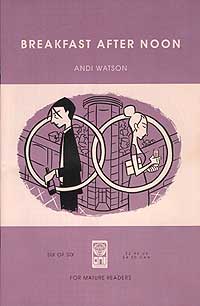
|
Rob, the focus of the series, has been laid off his factory job and feels obsolete in his late twenties. He lives with Louise, his fiancée, and they plan for the wedding in spite of this setback. Or rather, Louise plans while Rob becomes increasingly dispirited about The Whole Thing. Over the course of the six issues Rob goes to greater and greater lengths to unconsciously sabotage all his relationships.
It's a bold move to have an unfunny, unpleasant, rather pathetic character be your focus. But Watson has a skill with making Rob's downward spiral believable. He never resorts to clumsy pathos, and even succeeds in keeping just a hint of sympathy for the poor sod. It feels right.
You may notice similarities here with the work of filmmaker Mike Leigh, director of such British working-class dramas as "Secrets & Lies" and "Raining Stones." "Breakfast After Noon" doesn't have quite the grit of those films, though. The secondary characters aren't very fleshed out, and the story lacks the complexity of the Leigh films, which are also much more political than "Breakfast." On the other hand, you don't need subtitles to get past the accents.
In fact, part of the charm, for Americans anyway, will be the authenticity of the modern English scene, most noticeably the lingo. But it never prevents you from figuring out what they're saying. Watson, a native of England, kindly includes a glossary for such phrases as "cuppa" and "five-a-side."
Watson's drawing style is spare and square, in the literal sense. People's fingertips have two right corners and the layouts are easy-to-read grids. His lines are thick and heavy, mostly tracing the outline of things and leaving detail to the imagination. For variety and depth he uses a single shade of gray. You also get a sense of "Japanoise," as the expressionists would have said. I can't quite say why I think this. Perhaps because Watson's previous work was titled "Geisha."
The bad, and all-too-common way to validate an audience, is to reinforce its beliefs of itself. The good way, the "Breakfast After Noon" way, allows you to see your world or, even better, yourself, depicted in a work of art. Some of you, like the ex-dot-commers out there, sitting in your bathrobe reading this, will know just what Rob feels like. The rest of you can learn.
Finding all six issues of "Breakfast After Noon" in one place will be difficult. You should
only try the top-tier comic shops, both virtual and real. You can also get them from the
publisher's web site: onipress.com and they will be collected into a trade paperback in July. Andi Watson also has a web site: andiwatson.com
